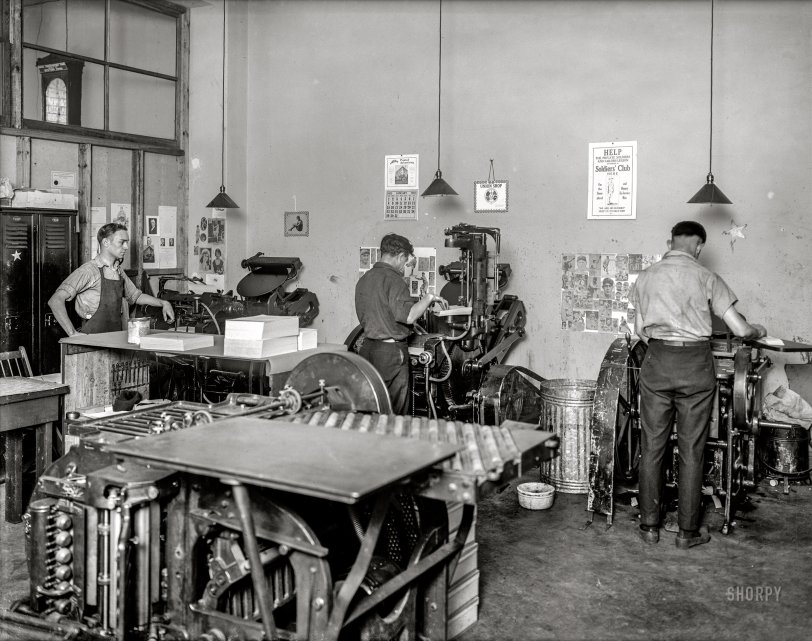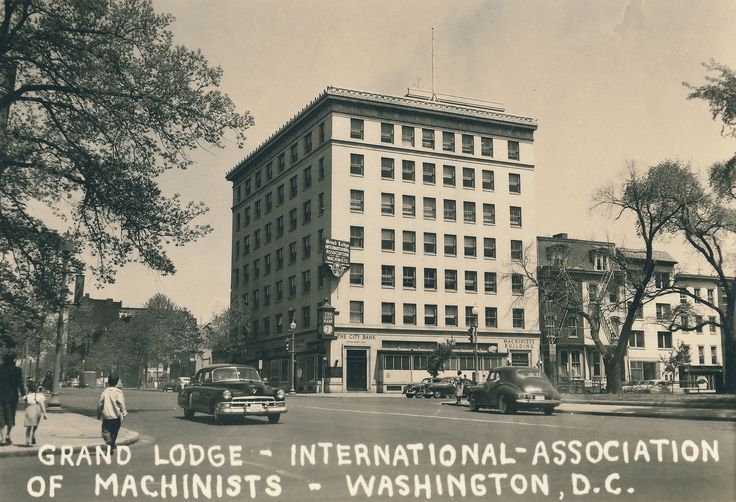


Framed or unframed, desk size to sofa size, printed by us in Arizona and Alabama since 2007. Explore now.
Shorpy is funded by you. Patreon contributors get an ad-free experience.
Learn more.

- Baldwin 62303
- Baldwin VO-1000
- Cold
- No expense spared
- Tough Guys
- Lost in Toyland
- And without gloves
- If I were a blindfolded time traveler
- Smoke Consumer Also Cooks
- Oh that stove!
- Possibly still there?
- What?!?
- $100 Reward
- Freeze Frame
- Texas Flyer wanted
- Just a Year Too Soon
- WWII -- Replacing men with women at the railroad crossing.
- Yes, Icing
- You kids drive me nuts!
- NOT An Easy Job
- I wonder
- Just add window boxes
- Icing Platform?
- Indiana Harbor Belt abides
- Freezing haze
- Corrections (for those who care)
- C&NW at Nelson
- Fallen Flags
- A dangerous job made worse
- Water Stop
Print Emporium
Print Shop: 1922

January 1922. Washington, D.C. "Machinists' Association -- printers." Activities relating to the International Association of Machinists. National Photo Co. glass negative. View full size.
Dang Near Cut My Finger Off!
Years ago my father owned a boutique printing company and an advertising agency. One of the printing presses was a letterpress, with moveable type. I remember watching him set type.
My brothers and I had the job of busting up the type and putting it back in the type drawers which were called 'cases'. The trade term for the kids who busted up the type was "printer's devil". Each font went into a different case and each letter went to a specific bin in the case. Woe to the devil who put a sort (pieces of type) in the wrong space! Now you know where the term 'out of sorts' originated!
I can still remember the layout of the cases and where each sort belonged. The type was made out of lead.
I remember how amazed I was the first time I saw a linotype machine.
This press was at a junk store. The press and all the type for $850. Years ago.
One day I was talking to my dad while he was running the press. I stumbled and laid my hand on the press for balance. The press was running and I about cut my index finger off. The finger, my right index finger, is crooked and shorter than my other fingers. I don't have much feeling in it and I don't use the finger much. I was maybe eleven or twelve years old.
Platen presses
As a former employee of a Dutch Company, Bührmann-Tetterode, that used to be an important player in Europe on the market for Platen Presses, I am delighted with pictures like this, showing print shops, like you may see them nowadays still frequently in Asian countries like Indonesia (the country where my wife was born when it was called Dutch East Indies). My firm represented the, rather famous, Heidelberger Druckmaschinen Gesellschaft in Europe, except for Germany and the U.K. The Original Heidelberg Platen Press was often referred to as the Heidelberg Windmill, which is a rather curious name for me as a Dutchman. The platen presses we see here may well be Chandler & Price platen presses.
Stop the Presses!
I also ran a letter press such as these in Industrial Arts class. The one we had was probably older than these. I also worked as printer for a few years in a check printing plant which used letter presses well into the 1980's. I ran Intertype Machines which were automatic type setters that cast the lead slugs used in the big presses. I'm sure I am one of the last people to ever have been trained on such machines, they were phased out about 2 years afterward.
I was trying to figure out what the tall structure on the center press was. The operator is hand-feeding the paper into the press. His right hand is on the unprinted stock. The press on the left has an auto-feeder (meaning the press is "sheet-fed"). You can see the vacuum lines which provide suction to lift the sheets of paper and draw them into the press. It dawned on me that the two presses, left and center, are identical. The center press is also sheet-fed, but the mechanism has been swung up, out of the way (the vertical structure) and is being hand-fed.
Hand feeding a letter press means you have to remove the freshly printed sheet with your left hand and put in a fresh sheet with your right hand as the press cycles open, and do so before it closes again. Meaning, BOTH of your hands are inside a running machine each cycle. Thats why the guys in the photo are concentrating so hard on what they're doing.
The machine in the fore-ground: my guess is that it's a folding machine.
Horological Accuracy -
Provided by the Naval Observatory, via Western Union.
Pay Attention
Lotsa ways to lose a finger or limb in this picture.
Upside upside down, but not backward
is actually the way to set type, and also from bottom to top, rather than top to bottom. It still works, and there are a few hundred of us who still on occasion set type by hand.
Model Models
Mightn't the images on the wall (models; baseball players) be samples of what the artisans are printing at their respective presses?
Before WordPerfect or even Atari Writer ...
I am reminded that my junior high school industrial-arts class (boys only, in those dark ages) included a month of weekly sessions on manual typesetting (in addition to wiring, woodworking, and metalworking). It started off with a hand-held composing stick onto which you placed letters from the wooden type case, upside down and backwards. You advanced to setting a whole page in a metal frame, inserting lead spacers between paragraphs and locking the whole thing solid with key-tightened springs around the border. The irascible instructor, Mr. L______, who seemed vaguely disgruntled with life, would walk around, tilting the frames upright and rapping your typeset assemblage in the middle. If the type collapsed into chaos on the bench, he'd smirk and say "Better sort it out and try again, tighter," then walk off. Oddly, despite the abundance of sharp or heavy tools in the area, he was never murdered. The uplifting part of the experience was that none of us had ever heard of a single alumnus who had ever made a living as a typesetter, or wished to. But I do not begrudge the experience: it taught me to respect the craftwork mastered by folks like the guys in the photo.
Sports section, women's section
Sports on the right, women's on the left, judging from the "halftones" on the wall in each location.
Manual Labor
I operated presses like that in high school, even had one in my garage for years. The pressmen are interesting, two have baseball pictures on the wall and the other guy has girls. I see a spittoon on the floor.
Moving on up
Looks like one of them has traded in his cards and bubble gum for something more adventurous.
The new female supervisor ...
has just advised the chap on the left that his choices for wall display in front of his press are inappropriate, and need to be removed.
Grand Lodge, International Association of Machinists
Just in case anyone was curious about the building on the calendar. Built in 1919, it sat across from the AFL-CIO building at 9th Street and Mount Vernon Place NW in DC.

A Century Ago
I'm no where near 100 years old, but my mind still has difficulty processing the fact that 1922 was already 100 years ago.
























On Shorpy:
Today’s Top 5